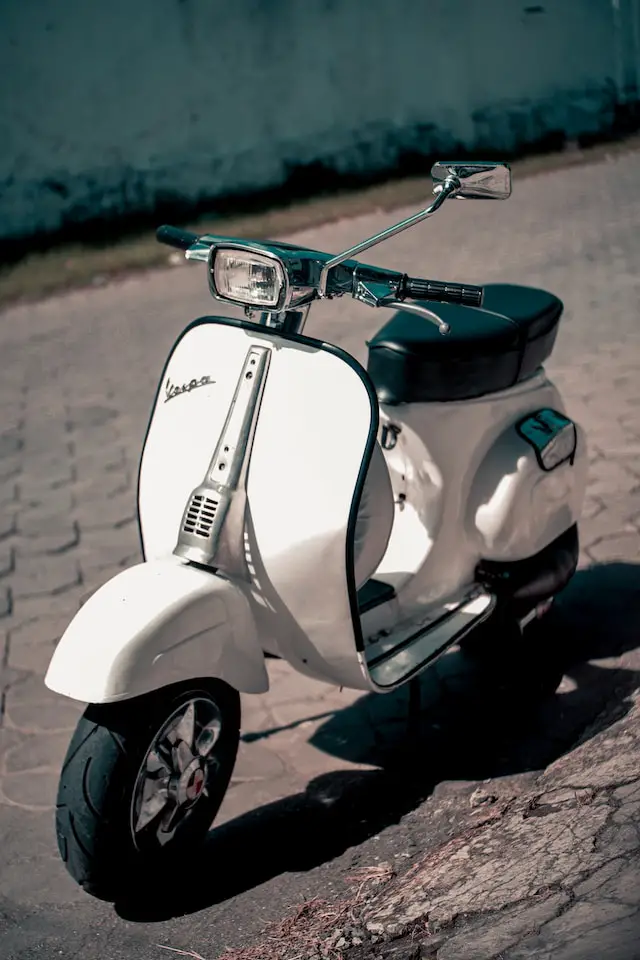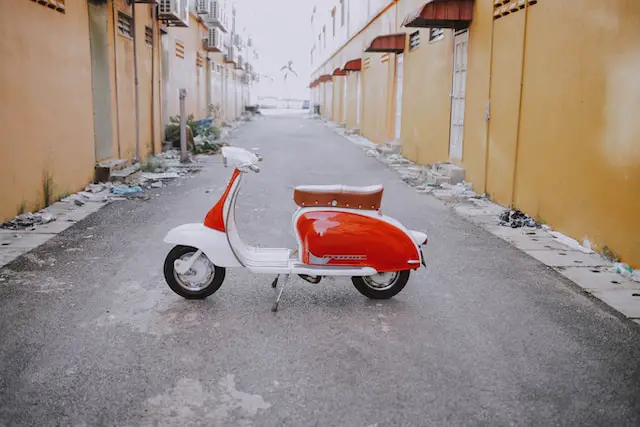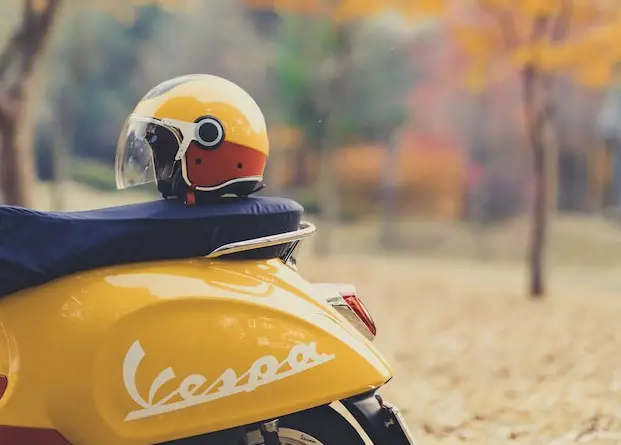Both Vespa and Lambretta are iconic Italian motor scooters, but they were produced by different manufacturers and have distinct design features. Generally, Vespa scooters are known for their more rounded body style, while Lambretta scooters are characterized by their sharp angles and larger, more powerful engines.
Vespa
(Photo by Wahyu Setiawan on Unsplash )

Vespa is an iconic Italian motor scooter brand that was first introduced in 1946. Known for its distinctive design, which features a rounded body and large, single headlight, the Vespa has become a symbol of Italian style and design around the world. Vespa scooters are known for their reliability, fuel efficiency, and ease of use, making them a popular choice for urban commuters and travelers. Today, the Vespa brand is owned by the Italian company Piaggio, which continues to produce new models and variations of this classic scooter.
Lambretta
(Photo by Firdaus Roslan on Unsplash )

Lambretta is another Italian motor scooter brand that was introduced in 1947, just one year after the Vespa. While similar in many ways to the Vespa, the Lambretta had a more angular and aggressive design, and was generally more powerful and faster than its rival. Lambretta scooters were particularly popular among younger riders and enthusiasts who valued their sporty design and performance capabilities. Today, the Lambretta brand is owned by a British company, and new models of Lambretta scooters are still being produced for enthusiasts and collectors around the world.
Vespa Vs. Lambretta – Key diffeences
The Vespa and Lambretta are both iconic Italian motor scooters that were introduced in the years following World War II, and they share many similarities in terms of their design and purpose. However, there are several key differences between the two brands:
Design: The Vespa is known for its rounded body and large, single headlight, while the Lambretta has a more angular and aggressive design.
Performance: Generally, Lambretta scooters were more powerful and faster than Vespa scooters, and were particularly popular among younger riders and enthusiasts who valued their sporty design and performance capabilities.
Ownership: Today, the Vespa brand is owned by the Italian company Piaggio, while the Lambretta brand is owned by a British company.
Availability: While both brands are still popular among enthusiasts and collectors, new models of Vespa scooters are more widely available than new models of Lambretta scooters, which are produced in smaller quantities for a more niche market.
Which is better? Vespa or Lambretta?
Choosing between a Vespa and a Lambretta depends largely on personal preference and intended use. Both brands have their own unique designs and features, and both have passionate communities of enthusiasts and collectors.
In terms of overall performance, Lambretta scooters were generally more powerful and faster than Vespa scooters, and were popular among younger riders and enthusiasts who valued their sporty design and performance capabilities. However, Vespa scooters have a reputation for being more reliable and easier to maintain.
Ultimately, the best choice between a Vespa and a Lambretta comes down to individual preferences in terms of style, performance, and brand history. It’s worth test riding both brands if possible and seeing which one feels like a better fit for you.
The advantages and disadvantages of a Lambretta
Advantages of a Lambretta:
- Powerful engine: Lambretta scooters were known for having powerful engines, making them a popular choice among enthusiasts who valued performance and speed.
- Sporty design: Lambretta scooters had a distinctive, sporty design that made them popular among younger riders and those who wanted a more aggressive, edgy look.
- Large wheels: Lambretta scooters had larger wheels than many other scooters of the time, which made them more stable and easier to handle on the road.
Disadvantages of a Lambretta:
- Maintenance: Lambretta scooters are known for being more difficult to maintain than other scooters, which can lead to higher repair costs over time.
- Cost: Lambretta scooters can be more expensive than other brands, due to their popularity and reputation as high-performance machines.
- Availability: Lambretta scooters are no longer produced, which can make finding replacement parts or accessories more difficult.
- Heavy weight: Lambretta scooters are typically heavier than other scooters, which can make them more difficult to maneuver in tight spaces or in traffic.
Lambretta scooters are a great choice for those who value performance and sporty design, but may not be the best option for those who prioritize easy maintenance or affordability.
The advantages and disadvantages of a Vespa
Advantages of a Vespa:
- Classic design: Vespa scooters are known for their iconic, timeless design, which has made them a popular choice for generations.
- Easy to ride: Vespa scooters are relatively lightweight and easy to handle, making them a great option for beginners or those who want a comfortable, hassle-free ride.
- Fuel efficiency: Vespa scooters are known for their excellent fuel efficiency, which can save riders money on gas and reduce their carbon footprint.
- Availability: Vespa scooters are widely available in many parts of the world, which makes it easier to find replacement parts or accessories when needed.
Disadvantages of a Vespa:
- Limited storage: Vespa scooters typically have limited storage space, which can be inconvenient for those who need to carry a lot of belongings or groceries.
- Low top speed: Vespa scooters are not known for their speed or acceleration, which can make them less appealing to riders who value performance.
- Cost: Vespa scooters can be relatively expensive compared to other brands, due to their popularity and reputation as a high-end product.
- Maintenance: Vespa scooters require regular maintenance to keep them running smoothly, which can lead to higher repair costs over time.
Vespa scooters are a great choice for those who value classic design, easy handling, and fuel efficiency, but may not be the best option for those who need lots of storage space or prioritize high performance.
Which is more expensive Vespa or Lambretta?
The prices of Vespa and Lambretta can vary depending on the model, year, and location. However, in general, Lambrettas are considered to be more expensive than Vespas due to their rarity and the high demand among collectors.
Vintage Lambrettas, particularly those from the 1950s and 1960s, are highly sought after by collectors and enthusiasts, which drives up their prices. On the other hand, Vespas are more common and easier to find, which generally results in lower prices.
Additionally, Lambrettas were only manufactured until the 1970s, while Vespas have continued to be produced until the present day, which means there are more Vespas available in the market, and this may contribute to their lower price point.
In conclusion, while there is no definitive answer to which is more expensive, in general, Lambrettas tend to command a higher price due to their rarity and historical significance.
Why is it called a Vespa?
The name “Vespa” was originally suggested by Enrico Piaggio, the founder of Piaggio & Co. SpA, the Italian company that produces Vespa scooters. The word “vespa” means “wasp” in Italian, and the scooter was named Vespa because its shape and buzzing sound reminded Piaggio of a wasp. The Vespa’s unique design was intended to be a departure from the typical bulky and noisy motorcycles of the time and aimed to create a more stylish and practical mode of transportation.
Why is it called a Lambretta?
The Lambretta was named after the Lambro River, which ran near the factory where it was manufactured in Milan, Italy. The Lambretta was produced by Innocenti, an Italian company that originally made steel tubing and was looking to diversify their product line after World War II. They acquired a license from the scooter maker Motovespa to produce their own version of a motor scooter and named it after the nearby river. The Lambretta became a popular mode of transportation in the 1950s and 1960s, especially among young people and mods, a subculture that emerged in London, England.
Why Vespa failed in India?
Vespa was first introduced to India in the 1960s and quickly became a popular mode of transportation among the middle class. However, the company faced a number of challenges that led to its decline in India.
One major factor was competition from Indian companies that were producing cheaper and more practical two-wheelers, such as Bajaj and Hero. Vespa’s scooters were seen as expensive and less fuel-efficient than their Indian counterparts.
Another issue was that Vespa did not adapt well to the changing needs and preferences of the Indian market. As demand for more powerful and versatile scooters grew, Vespa continued to produce its classic models without making significant updates or changes.
Additionally, the high import duties on Vespa scooters made them more expensive than their Indian counterparts, limiting their appeal to cost-conscious consumers.
All these factors contributed to Vespa’s declining sales and eventual exit from the Indian market in the 1980s. However, in recent years, Vespa has made a comeback in India with new models and a focus on style and design, targeting a niche market of premium scooter buyers.









